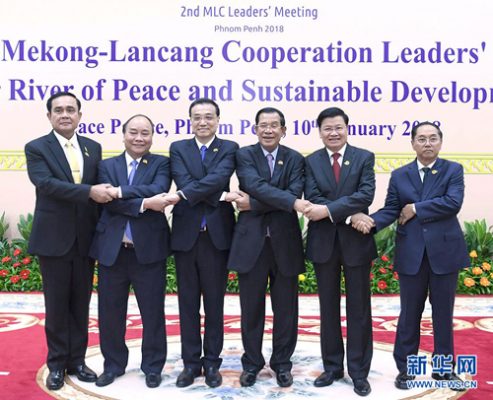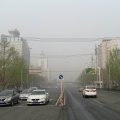
I. Development Goals
1. This Plan of Action is formulated in accordance with documents including the Sanya Declaration adopted at the first Lancang-Mekong Cooperation (LMC) Leaders’ Meeting, which aims at contributing to the economic and social development of sub-regional countries, enhancing well-being of the people,narrowing the development gap within the region and building a Community of Shared Future of Peace and Prosperity among Lancang-Mekong Countries. By synergizing China’s Belt and Road Initiative and the ASEAN Community Vision 2025 as well as the Master Plan on ASEAN Connectivity 2025 and visions of other Mekong sub-regional cooperation mechanisms,the LMC is moving towards a new sub-regional cooperation mechanism with unique features driven by internal strength and inspired by South-South cooperation, which will support the ASEAN Community building and regional integration process, as well as promote the implementation of the UN 2030 Agenda for Sustainable Development.
II. Fundamental Principles
2. This Plan of Action will take into account the development needs of the six LMC member countries and the regional integration process, reflect the framework established in the Sanya Declaration, highlighting the leaders’ guidance, all-round cooperation and broad participation, and follow a government-guided,multiple-participation,and project-oriented model so as to further explore the most suitable cooperation model for the Sub-regional cooperation in line with the unique features and specificity of the six countries. The implementation of this Plan of Action will be based on the principles of consensus, equality, mutual consultation and coordination, voluntarism, common contribution and shared benefits, and respect for the United Nations Charter and international laws, as well as in accordance with domestic laws, rules, regulations and procedures of each member country. Years 2018 and 2019 will be the foundation-laying stage,when emphasis should be focused on strengthening sectorial cooperation planning and implementing small and medium-sized cooperation projects. The years 2020–2022 will be the consolidation and expansion stage, when member countries will further strengthen the cooperation in the five priority areas and may explore new cooperation areas that help respond to the development needs of member countries,optimize cooperation model and gradually explore cooperation on large projects.
III. Working Structure
3. Optimize the multi-layer framework comprising Leaders’ Meeting, Foreign Ministers’ Meeting (FMM), Senior Officials’ Meeting (SOM) and Diplomatic and Sectoral Joint Working Group Meeting.
4. Strengthen communication and coordination among the LMC National Secretariats or Coordination Units of the six member countries, and explore the possibility to set up the LMC International Secretariat.
5. Submit implementation progress report of this Plan of Action to the Foreign Ministers’ Meeting through the Senior Officials’ level Meeting annually. A list of projects proposed by the six member countries for the next year will be submitted to the FMM for adoption.
6. Upon consensus of the six countries, gradually upgrade the Joint Working Groups on the priority areas to senior official’s level or ministerial level. In parallel with enhancing cooperation in the key priority areas, cooperation in other areas are also encouraged.
7. Design LMC logos and other symbols for the LMC.
8. Complement and develop in synergy with other Mekong sub-regional cooperation mechanisms.
9. Coordinate the LMC and ASEAN-China Cooperation by exploring communication with ASEAN-China Joint Cooperation Committee and strengthening cooperation with ASEAN-China Center and other ASEAN-relevant institutions on ad hoc basis.
IV. Practical Cooperation
4.1 Political and Security Issues
4.1.1 Maintain High-level Exchanges
10. Convene the LMC Leaders’ Meeting once every two years to map out strategic planning for future LMC development and hold ad hoc Leaders’ Meeting as necessary on the basis of consensus.
11. Hold Foreign Ministers’ Meeting once a year to implement consensus reached at the Leaders’ Meeting, review cooperation progress and provide suggestions for cooperation.
12. Maintain regular contacts among leaders of the six countries through bilateral visits or other international cooperation platforms.
4.1.2 Strengthen Political Dialogues and Cooperation
13. Hold Diplomatic Senior Officials’ Meeting and Joint Working Group meetings in diplomatic and other sectors each year as needed.
14. Support policy dialogues and official exchanges and visits among Lancang-Mekong countries.
4.1.3 Exchanges among Political Parties
15. Promote dialogues and exchanges among political parties of Lancang-Mekong countries in line with the spirit of LMC.
4.1.4 Non-traditional Security Cooperation
16. Deepen law enforcement dialogues and cooperation in combatting non-traditional security issues on mutual interest.
17. Jointly strengthen cooperation in the field of non-traditional security issues, such as combating drug trafficking, terrorism, organized illegal crossing of national border,human trafficking, smuggling and trafficking of firearms and ammunition, cyber crimes and other transnational crimes.
18. Promote exchanges among local/regional governments of border areas as well as border management departments of Lancang-Mekong countries, in line with the spirit of LMC and domestic rules and regulations of each member country.
19. Strengthen cooperation among police agencies, judicial agencies and related colleges and universities among Lancang-Mekong countries.
20. Enhance cooperation in the fields of disaster prevention and mitigation as well as humanitarian assistance, ensuring food, water and energy security. Explore various solutions for supporting people affected by disasters and the impacts of climate change.
4.2 Economy and Sustainable Development
4.2.1 Connectivity
21. Compose a plan on connectivity by synergizing with the Master Plan on ASEAN Connectivity 2025 and other sub-regional plans so as to promote comprehensive connectivity among Lancang-Mekong countries and explore the possibility to establish a Lancang-Mekong cooperation corridor.
22. Promote infrastructure upgrade and construction, such as railway, highway, waterway, ports, power grid, information network and aviation. Increase application of global satellite navigation systems, including the Beidou System, in Lancang-Mekong countries in areas such as infrastructure construction, transportation, logistics, tourism and agriculture.
23. Promote facilitation of visa application, customs clearance and transportation, and discussion on implementing the “single window” model for cross-border clearance.
24. Enhance cooperation in regional power grid planning, construction, upgrading and renovation to promote power connectivity and power trade among Lancang-Mekong countries toward the establishment of an integrated regional power market.
25. Formulate a broadband development strategy and relevant plans for Lancang-Mekong countries, actively push forward construction and expansion of cross-border terrestrial fiber optic cables and international submarine cables. Explore new cooperation models in terrestrial fiber optic cables across multiple countries, augment the existing regional network utilization, and constantly improve network connectivity among Lancang-Mekong countries.
26. Enhance cooperation in innovative development of digital TV, smart phone, smart hardware and other related products.
27. Promote mutual recognition of standards and credentials, share related development experience and improve capacity building cooperation.
4.2.2 Production Capacity
28. Formulate a Plan of Action on Production Capacity Cooperation among Lancang-Mekong countries in accordance with the Joint Statement on Production Capacity Cooperation among Lancang-Mekong Countries.
29. Enhance capacity building on production capacity improvement, and carry out best practice exchanges and training.
30. Explore the possibility to set up platforms for production capacity and investment cooperation, hold activities including the Production Capacity Cooperation Forum for Lancang-Mekong countries and explore the establishment of an alliance for promotion of production capacity and investment cooperation among Lancang-Mekong countries.
31. Encourage enterprises and financial institutions of Lancang-Mekong countries to participate in production capacity cooperation.
32. Explore the establishment of an LMC production capacity cooperation development fund with multi-lateral participation.
4.2.3 Economy and Trade
33. Promote cross border economic cooperation through construction of pilot cross border economic cooperation zones, and work together to optimize cooperation framework, working mechanism and institutional arrangements.
34. Improve trade and investment facilitation among Lancang-Mekong countries, and work to further reduce non-tariff trade barriers.
35. Establish a Lancang-Mekong business council. Explore the development of a service alliance for small and medium-sized enterprises.
36. Strengthen trade promotion activities among Lancang-Mekong countries such as organizing international trade fairs, exhibitions, and business-matching sessions.
4.2.4 Finance
37. Work together to build a long-term, stable, sustainable and diversified financing system among LMC member countries, taking into account various financing principles for regional cooperation, including the Guiding Principles on Financing the Development of the Belt and Road.
38. Strengthen cooperation and exchanges among financial authorities of Lancang-Mekong countries to prevent financial risks.
39. Emphasize the importance of a stable financial market and sound financial structure to the development of real economy; support efforts to enhance capacity for and coordination on financial supervision and regulations; continue studies and exchange experiences in order to facilitate the use of bilateral currency swap, local currency settlement and cooperation among financial institutions.
40. Strengthen cooperation with institutions including Asian Development Bank,Asian Infrastructure Investment Bank, Asia Financial Cooperation Association, and World Bank.
41. Encourage financial institutions to facilitate business operations in order to support regional trade and investment. Enhance the development of products and services via a diverse set of providers and channels to promote inclusive finance and sustainable growth in the Lancang-Mekong region.
4.2.5 Water Resources
42. Carry out top-level design for cooperation among LMC countries in sustainable water resources utilization, strengthen policy dialogue on water resources,and regularly hold Lancang-Mekong Water Resources Cooperation Forum.
43. Advance the building of Lancang-Mekong Water Resources Cooperation Center with a view to create a comprehensive cooperation platform to support Lancang-Mekong water resources cooperation.
44. Promote technical cooperation and exchanges on water resources management,carry out joint research and analysis related to Lancang-Mekong water resources and influences of climate change, etc., and implement pilot projects and priority cooperation projects on sustainable water resources development and protection technology.
45. Enhance and promote capacity building on water resources management by carrying out academic programs, programs of exchanges, training, field trips and study tours.
46. Develop and improve water quality monitoring system, which is accessible to all Lancang-Mekong countries, strengthen data and information sharing.
47. Deepen Lancang-Mekong river flood and drought disaster emergency management, carry out joint assessment of flood control and drought relief in Mekong basin, and carry out joint study on the early setting up of communication line/channel for sharing information in emergency case of flood and drought in Lancang-Mekong river.
48. Formulate a Five-Year Action Plan on Water Resources Cooperation in which issues of common concerns will or can be addressed.
4.2.6 Agriculture
49. Strengthen policy coordination, and strengthen coordination to ensure food and nutrition security, and food safety, promote investment opportunity and enhance cooperation on sustainable agricultural development.
50. Expand exchanges and cooperation in agricultural science and technology. Support research institutions to enhance information sharing, communication and exchange of visits. Build joint laboratories, demonstration bases and technology centers and establish the LMC agricultural information network.
51. Hold the Village Head Forum among Lancang-Mekong countries.
52. Advance quality and safety cooperation for agricultural products, promote trade in agricultural products, create an integrated Lancang-Mekong market for agricultural products, and enhance competitiveness of regional agricultural products.
53. Carry out cooperation in monitoring, early warning, joint prevention and control of animal and plant diseases and epidemic situation. Enhance veterinary cooperation. Cooperation on water resources conservation. Establish the mechanism of exchange and cooperation on ecological conservation along the Lancang-Mekong River and jointly set up wild fish breeding and rescue centers for information sharing, for example, information on fish diversity, fish abundance and fish migration, etc. as well as possibility and opportunity on fishery cooperation, such as strengthening capacity building in aquaculture development.
54. Explore the possibility to jointly build agricultural industry cooperation parks and guide non-governmental sectors to participate in construction and operation of the parks.
4.2.7 Poverty Reduction
55. Formulate the Five-Year Plan of the Lancang-Mekong Cooperation on Sustainable Poverty Reduction and strengthen the experience exchange and knowledge sharing among Lancang-Mekong countries.
56. Enhance various capacity building programmes and experience sharing on poverty reduction, including sufficiency economy philosophy (SEP), launching the village officials exchange and training program for Lancang-Mekong countries. Strengthen the poverty reduction capacity of the Lancang-Mekong countries through multi-level and all-dimensional capacity building activities, such as personnel exchanges, policy consultation, joint research, training, information sharing and technical support.
57. Launch poverty reduction pilot projects in Mekong countries.
4.2.8 Forestry
58. Enhance conservation and use of forest resources, promote integrated management of forest ecosystem along the Lancang-Mekong River.
59. Enhance trade volume of forest products produced from legally acquired raw materials, promote development of small community forest enterprises, strengthen forest law enforcement and governance, promote cooperation in combating illegal logging and associated trade, enhance scientific and technological cooperation and exchange in the forestry sector, and enhance forest rehabilitation and forest plantation along the Mekong River.
60. Enhance cooperation in prevention and control of forest fire in border areas.
61. Enhance wildlife conservation cooperation and jointly fight against illegal wildlife trade.
62. Improve capacity building of Lancang-Mekong countries in forestry management and scientific research, promote forestry-related higher-education and human resource cooperation, conduct thematic training and carry out scholarship and visiting scholar projects.
4.2.9 Environmental Protection
63. Promote the establishment of Lancang-Mekong Environmental Cooperation Center. Synergize environmental protection development plans of Lancang-Mekong countries and formulate the Lancang-Mekong Environmental Cooperation Strategy.
64. Formulate and implement the Green Lancang-Mekong Plan, with the focus on cooperation in better managing air and water pollution as well as ecosystem management and enhance communication with other related sub-regional mechanisms.
65. Strengthen cooperation on environmental protection capacity building, publicity and education, and enhance public environmental awareness.
4.2.10 Customs and Quality Inspection
66. Explore the formulation of cooperation plans, and gradually promote the convening of meetings among customs and quality inspection departments of the six countries.
67. Improve the speed of clearance for goods, especially agricultural products.
68. Enhance product standardization, promote training, cooperation and mutual recognition on certification and accreditation. Carry out metrology assistance to improve the metrology capacity building in Lancang-Mekong countries.
4.3 Social and Cultural Cooperation
4.3.1 Culture
69. Share information on culture-related policies. Promote cultural dialogue and work to implement the Ningbo Initiative on Lancang-Mekong Cultural Cooperation.
70. Deepen exchanges and cooperation on culture and arts, cultural relics preservation, preservation of intangible cultural heritage, cultural industry, and human resource development in cultural sectors, and encourage interaction and collaboration among cultural institutions, art companies and troupes, and cultural enterprises.
71. Make full use of cultural centers set up by governments of LMC countries to host such cultural activities among LMC member states.
4.3.2 Tourism
72. Explore the establishment of the Lancang-Mekong Tourism Cities Cooperation Alliance.
73. Promote the training of tourism talents, and encourage Lancang-Mekong countries to participate in relevant tourism events and activities such as ASEAN Tourism Forum, Mekong Tourism Forum and China International Tourism Mart (CITM).
74. Explore the possibility of establishing a medium/long term tourism development vision of the LMC, aiming at enhancing soft-infrastructure and hard-infrastructure tourism development.
75. Enhance the recognition on Promoting ASEAN Tourism Standards.
4.3.3 Education
76. Promote activities to enhance collaboration among Lancang-Mekong Countries during China-ASEAN Education Cooperation Week.
77. Strengthen vocational education and training, support the establishment of Lancang-Mekong Vocational Education Base in China as well as Lancang-Mekong Vocational Education and Training Center in Mekong countries.
78. Promote cooperation among universities and colleges in Lancang-Mekong region, encourage them to conduct joint training and research programs, academic exchanges and explore recognition and transfer of study credits.
4.3.4 Health
79. Strengthen cooperation on the prevention and control of emerging and re-emerging infectious diseases, including dengue fever and malaria. Establish and improve the mechanism for early warning, joint surveillance, prevention and control for cross-border emerging and re-emerging infectious diseases.
80. Enhance cooperation among hospitals and medical institutions to facilitate technical exchanges and health personnel training. Advance cooperation in building hospitals in rural areas among the six countries.
81. Offer short-term medical consultation service,such as Brightness Action, Smile Action (Medical Treatment to Facial Deformation) and medical service for women and children for free. China will dispatch medical teams to Mekong countries in need.
4.3.5 Media
82. Strengthen exchanges and cooperation among mainstream media, and encourage the hosting of TV and film festivals or screening activities.
83. Encourage foreign ministries of the six countries to set up Lancang-Mekong Cooperation official websites or to provide official information about LMC on their websites. Using social media platforms as basic platforms to publish information and handle public affairs as deemed appropriate.
84. Launch a Lancang-Mekong magazine or news brochure, and establish a database for Lancang-Mekong cooperation.
4.3.6 People-to-people Exchanges and Local/Regional Government Cooperation
85. Through organizing various people-to-people activities, enhance the branding of the LMC and raise public awareness of the LMC in the six countries.
86. Promote youth exchanges and build flagship youth exchange projects among Lancang-Mekong countries.
87. Enhance gender equality, women’s exchanges and cooperation by developing various forms of activities including training courses and exchange of visits.
88. Mobilize the local/regional governments of the six countries in participating in the LMC and encourage their participation in the projects.
89. Encourage non-governmental organizations to participate in the LMC projects as appropriate.
90. Strengthen exchanges among Red Cross Societies, develop community resilience program, and improve the capacity building of the Red Cross Societies in Lancang-Mekong countries.
91. Encourage visits of personnel and communication to support the cooperation on state management of religion and inter-religious affairs as deemed appropriate by member countries.
V. Supporting System
5.1 Funding Support
92. Fully utilize the LMC Special Fund set up by China. Support, as priorities, projects that are adopted by Leaders’ Meeting or Foreign Ministers’ Meeting and are in line with the goals set by the Sanya Declaration and other important documents agreed on by the Leaders and Foreign Ministers. Encourage more financial and resources inputs from the six countries. Actively seek support from financial institutions such as Asian Infrastructure Investment Bank, the Silk Road Fund and Asian Development Bank. Leverage social and market resources, and establish an all-round financial support system.
5.2 Intellectual Support
93. Explore a cooperation model that incorporates government, business and academia, work together on establishing the Global Center for Mekong River Studies and gradually form a Track II team and think-tank network on Lancang-Mekong Cooperation.
5.3 Supervision Mechanism
94. Utilize the LMC National Secretariats or Coordination Units of the six countries. Strengthen cooperation in various areas and coordinate resources to form synergy. Supervise and advise relevant departments /agencies of their own countries to participate in cooperation and conduct regular assessment of major activities. Leverage resources of non-governmental professional institutions, which can play the role of third-party supervision.


